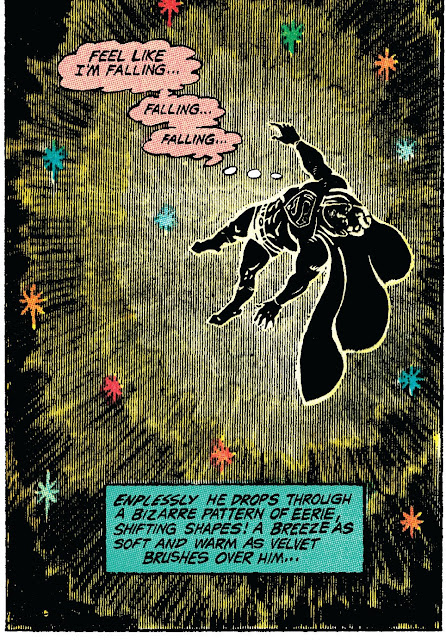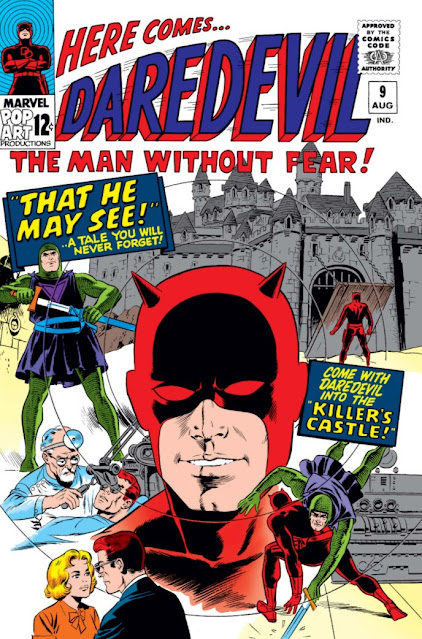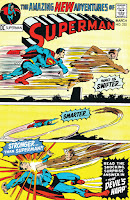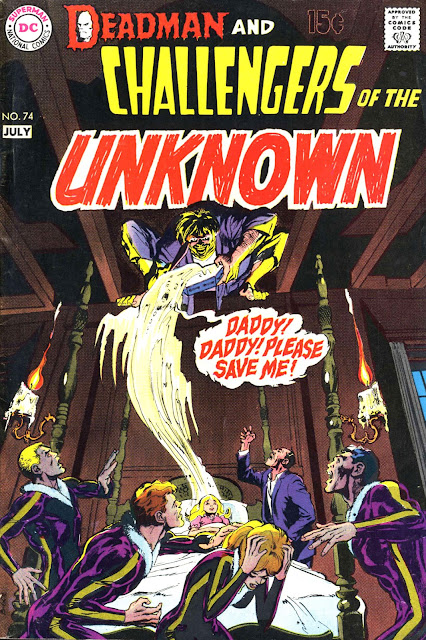SUPERMAN #236 April 1971
"HELP! SAVE ME!" screams Lois Lane, her entire body enveloped by flames. Superman looks on in horror powerlessly as a pair of storybook devils taunt him to "enter the gates of Hell!" Neal Adams' cover to SUPERMAN #236 promises a terrifying tale of the afterlife which would have sent a shudder down the spine of impressionable Sunday School-attending kids for whom the fires of Hell might have seemed as substantial as the world we know-- the heavy, gargoyled doors seen here merely adding an extra distressing element.
A month ago I wrote a piece on FOREVER PEOPLE #1 in which I contended that Kirby's visualisation of the Boom Tube was reminiscent of illustrations of Dante's INFERNO with its concentric circles (you can check it out here). At the story's conclusion Superman had himself entered the portal before opting to resume his position of responsibility here on Earth. In this issue he inadvertently finds himself falling through 'a bizarre pattern of eerie, shifting shapes' not wholly dissimilar to the Boom Tube as if imagined by Swan and Anderson (who I understand are affectionately known as Swanderson).
And this time he does indeed end up, like Dante's narrator, 'in the center of a raging Inferno'.
Lo and behold he is immediately set upon by 'a pack of screeching demons' straight out of Dante or Milton. The Man of Steel's first thought is that he's wound up in "a hell out of a medieval painting!"
Having sent the horned devils packing, Superman is greeted by a group of winged angels, who introduce themselves as Gabriel, Raphael and Michael, informing our hero that where he now stands is Heaven.
The Kryptonian seems to accept that he must be dead, and at this stage the evidence certainly seems to indicate that to be the case.
But of course we know that he isn't. Because despite what I feel is a fairly intriguing scenario, and one that I would have been pretty happy to accept, writer Denny O'Neil has given the game away on page one. Or maybe, I thought, O'Neil himself is not to blame, maybe it was an editorial decision to title this story PLANET OF THE ANGELS, instantly informing readers that what they're about to read is taking place on ANOTHER PLANET, not in the afterlife or even another dimension. I mean, it could easily have been named REALM OF THE ANGELS without the unforced spoiler, or PLACE OF THE ANGELS or just SOMETHING ENTIRELY DIFFERENT...!
I did wonder whether this may have been a necessary concession to the Comics Code Authority, that after the Halloween Horror of the cover image it was perhaps necessary that the sensitive souls reading this in 1971 knew the whole thing was something of an illusion from the get-go. But this turned out not to be the reason, either-- a glance at the code informs me that no such restrictions were in place, so even if it was an editorial decision then it wasn't done to appease the moral guardians. And then as I considered the story and what I feel lies behind its imagery, the penny dropped-- suddenly the title made complete sense and I realised that an alternative would not have been so appropriate. But before I get to that I need to lead you like Virgil leading Dante through Hell on a journey to uncover the sources of Denny O'Neil's story-- so, I warn you now-- "Abandon hope all ye who enter here!"
Blake's painting above is part of a rich cultural tradition which Western civilization has firmly embedded in us, influencing the way we read and understand stories like PLANET OF THE ANGELS. So much so in fact, that even Swanderson's title page image is subliminally reminiscent of this entrance to Hell, with its use of a coffin-shaped archway to enclose the lettering, and Superman's raised arm redolent of Dante's raised arm-- the principal difference of course being that unlike Dante, Superman must make his journey into 'Hell' alone. And in this story, Swanderson have elected to illustrate the demons as Satyrs, or the Greek deity Pan, full in the knowledge that all readers will instantly recognise the horns and cloven hooves as signifiers of the satanic, despite the figure originating independently of Abrahamic faiths--
My research reveals that this wasn't the first time the denizens of Hell appeared in a Superman family title-- For instance Lex Luthor turns out to be Lucifer, looking distinctly like Ming the Merciless, in one Silver Age story--
In fact, despite its pre-1971 disapproval of vampires, zombies and the like, the Authority seemed content to endorse plenty of comics in which crimson-fleshed demons appeared, such as this example from UNKNOWN WORLDS in 1963-- or this little trident-carrying critter-- HOT STUFF, dating back to the late fifties-- clearly comfortable with the image of horns and tails that had been a mainstay of Western art for hundreds of years.
And we mustn't forget that Marvel's DAREDEVIL, a well-established character by this time, wore, as his name might suggest, a costume that is a streamlined version of the Devil's own appearance-- Significantly, the character is of course heroic-- despite his appearance he is no 'Devil'. But we'll come to that later.
So, as indicated above. As I read the story I was at a loss really to understand why this twist in the narrative was telegraphed the way it was from the start. Maybe, I thought, if I'd been reading this story as a child fifty years ago it wouldn't have seemed so obvious. But coming to the story for the first time as an adult in 2021 I couldn't help but feel disappointed that the impact of a moment such as the dramatically low-angled appearance of these ornate, spiked gates surrounded by flames is diminished by the knowledge that Superman isn't really in Hell but just on some strange planet--
The same seemed true of the following page, as the Man of Steel encounters the "grinning ... mocking" faces of his friends as they're seemingly consumed by flames in "the pit of the doomed". I knew that Jimmy, Lois and Batman weren't really there because of that damned (sic) title. So why the Hell (sic) had O'Neil done it??
I'm just coming to that. But before I do, I think it's worth considering at this point how such images might have been understood by readers of SUPERMAN #236, especially younger ones, on original publication. How would they have understood the concepts of Hell and demons? Having grown up in a church-going household myself I accepted everything I heard in Sunday School and morning assemblies completely at face value, which I don't think is unusual. I probably didn't hear too much about the Devil or demons when I was very young, but my concept of them as I got older was very much shaped by my reactions to some images which I found quite troubling, and it's possible some readers of PLANET OF THE ANGELS felt the same way.
One of the most memorable visualisations of the Devil that I can remember is the crimson-coloured one below from a picture Bible I had as a child. This image really spooked me, it's beautifully painted with its flowing robes so lifelike. But I imagine I wasn't the only child who saw this picture and shuddered. Maybe that was the intention. Even now, all these years later, this is the first image that comes to my head if I think of the word 'Devil'. (It's worth noting that this is the Hamlyn/Golden Pleasure publication which infamously depicts Jesus as a blond-haired, blue-eyed Caucasian...!)
When I was a bit older I became quite troubled by the notion of Hell, a place where you might end up for the whole of eternity burning in agony in unquenchable flames. Things weren't helped when, without warning, I came across a comicbook sequence which really did concern me in TINTIN - THE BROKEN EAR (the second of Herge's popular children's series that I owned actually). It's unlike anything in the other TINTIN books, and as a child I really used to wonder why it was there, it seemed to be so nightmarish- though I'm certain now that Herge intended it as a harmless joke. The cartoony appearance of the grinning demons only served to make them seem more sinister and did nothing to reassure me that this kind of thing didn't await unrepentant sinners--
Which brings me to the third instance of my abiding memories of images of satanic forces from childhood. I attended a fanatically religious school from the age of 11, and on a couple of occasions we were taken en-masse by our teachers to visit the Christian bookshop housed on a ship called the Logos which sailed all over the world bringing religious propaganda to the gullible and impressionable. Being both gullible and impressionable, and an avid comic reader, I was drawn to the miniature cartoon-strip booklets on sale, whose amusing, innocent-looking illustrations (and low selling price) made me an instant buyer. This is the one whose cover most appealed to me because it looked so much like an image from the harmless British humour-comics I loved like SHIVER & SHAKE or WHOOPEE.
If the above image means nothing to you then count yourself lucky. Perhaps your only familiarity with this insidious publication and its dozens of companion-titles is by proxy- via a modern website or even Daniel Clowes' wonderful parody, DEVIL DOLL. Or maybe you too visited the Logos when it sailed into your nearest port, or were handed one of these by a Sunday School teacher or well-meaning pastor. In which case you'll recognise it immediately-- Yes, I was an unsuspecting consumer of what are now called Chick Tracts, publications whose contents are seen to be so repugnantly contentious and unashamedly hate-filled that the content-filters on my lap-top forbid me to visit the creator's website today. It's staggering for me now to recall that my teachers actively encouraged us to buy this trash, and that wide-eyed and credulous as many of us were, we soaked these up as literal, unburnished truths. The image below, the conclusion to A DEMON'S NIGHTMARE has stayed with me, and I am not afraid to admit that my impressionable younger self was terrified by this stuff. It was all about how you would end up in Hell if you didn't accept Jesus as your "personal savior", the thoughts of which genuinely kept me lying awake for hours--
So I think it's fair to say that my own ideas of Hell, the Devil and demons were very much the result of my religious upbringing and schooling and the influence of the examples above. It's difficult, though, to fully understand how the story in SUPERMAN #236 might have impacted on a child whose family practised a different faith, or for whom religion was no big deal in their lives period. Would they have been as scared as I'd have been? I doubt it, but perhaps they'd have been frightened in the way they might by any other Horror comic cover. I think it's fair to say that Neal Adams' image was definitely intended to terrify! Already well-established as a scare-merchant with his horrific covers for titles like HOUSE OF MYSTERY or THE PHANTOM stranger (which I've previously looked at here) Adams had form for bringing his haunting touch to regular superhero books, most notably this demonic image for BATMAN #227 (my thoughts on which you can find here)--
Returning to Superman, whether it was editorial policy or merely coincidence, the Kryptonian seemed to be running into demonic characters fairly regularly around 1970-71. Over at Marvel the SILVER SURFER had encountered the character of Mephisto shortly before the title was cancelled in 1970, so it's not unreasonable to assume the creators at DC decided to introduce some sinister, demonic flourishes to their best-selling character's world.
Perhaps the most eye-popping example was in the pages of LOIS LANE #103, whose cover depicts the lovely Lois about to be married to the Devil himself. And to make matters worse, she "has been turned into a demon" herself, complete with horns, tail and cloven hooves.
The devilish figure of course turns out (spoiler alert!) not to be Satan at all and naturally there's a return to the status quo before the end of the issue. Fortunately, now that I'm a lot older than I was when I was exposed to Jack Chick's bilious offerings, I can view a cover like this with a lot of pleasure. I'm certain though that one of the reasons it makes such an impact has less to do with 'The Devil' and his demonic hoards here, and more to do with the depiction of Lois. You can cut it whichever way you like, but this is a very sexy look for Ms Lane, and unsurprisingly a visual trope well-recognised as having a very particular appeal. Here for instance is a mid-sixties Smirnoff ad which offers the customer 'a devilishly dry proposition' to 'make a pact', just like Faust with the lady concerned--
Similarly who could resist the satanic allure of Julie Newmar in the TWILIGHT ZONE episode OF LATE I THINK OF CLIFFORDVILLE? (You can see that I've moved on somewhat from my Chick Tract-reading days, I hope.)
Alas there are no lady-demons in #236, nor were there any in the previous issue, #235, in which just a month earlier the Man of Steel had confronted a character who also resembled the Devil, or so its cover would have us believe.
This time the infernal foe turned out to be the very human Ferlin Nyxly, and his appearance was the result of him dressing as the mythical Greek god Pan (you can find my full post on that story here)--
Nyxly's outfit seems very much in keeping with the demonic figures we now find in SUPERMAN #236, which is fitting really considering how the Pagan figure of Pan was appropriated for early visual depictions of the Devil and his minions--
Superman is correct to identify the goat-like features as being reminiscent of mediaeval art, such depictions originating around the ninth century. For fifteenth century artist Hieronymus Bosch, hoards of grotesque demons were a popular choice for his terrifying tableaux of hell, though visually these beings took on all manner of forms, often animalistic, as they tormented the human dead--
By the nineteenth century Gustave Dore seems to have set a more fixed template for the way we visualize demons and devils in his illustrations for Milton's PARADISE LOST and Dante's INFERNO. Unlike the satyr-like figures in SUPERMAN #236, Doré's devils often sport impressive wings, and have the chiselled features and brooding intensity of the figures later repurposed in the comic works of Neil Gaiman amongst others--
Certainly by the Twentieth century there was a proliferation of images of the Devil or demons with a far more humorous, less sinister edge, as typified by Walter Houston's performance in 1941's THE DEVIL AND DANIEL WEBSTER, and maybe these were the way original readers of SUPERMAN #236 thought of demonic entities-- (and I warn you now that coming up in a moment are some images which might be considered NSFW)
Or here's another ad, this time a light-hearted promotion of a dead animal product featuring a male version of the Smirnoff girl. Could something like this trouble a young mind? It seems unlikely.
I wonder if the red-suited tempter got his get-up from the same outfitter as the fiendish gentleman on the cover of this curious publication from 1965?
Not that I'm trying to suggest that young comicbook readers in 1971 would have somehow got their hands on their Dads' dodgy mags, but it gives a fair indication of how the Devil could be seen as a comical figure within the media. And when celebrities such as movie star Jayne Mansfield became involved with 'The church that worships Satan', it must have seemed a great opportunity for a somewhat camp photo-shoot, the photographers undoubtedly relishing the sight of its leader dressed up in in full Luciferian outfit--
Then there were the Rolling Stones whose attempts at rehabilitating the Devil, seemed to playfully suggest that Old Nick might fit in well with their own hedonistic rock 'n' roll lifestyles, undoubtedly leading rock bands and their devotees to develop a fixation with the satanic for decades to come--
But it wasn't all fun and frolics as far as depictions of diabolical matters were concerned in the period immediately leading to the publication of SUPERMAN #236. The most cursory glance at the number of Horror films being released throughout the decade and into the seventies that had the words 'devil' or 'demon' in their titles almost equals the number that don't (despite the fact most of them weren't really about the devil or demons), suggesting that the Lord of Flies could still chill audiences--
And images of the devil, or merely the spurious use of demonic-sounding phrases have of course been a popular means of attracting readers of trashy novels for decades, again occasionally with a genuine intention to scare, but more often normalising the idea that the satanic is more about sensationalism than genuine frights--
So by 1971, the devilish figure had become firmly enshrined (sic) in popular culture simultaneously as the sinister embodiment of pure evil and as a 'naughty', roguish character across movies, art, literature, music, family entertainment, adult magazines, advertising and comedy. All of which leads me to the conclusion that, depending on a young reader's own upbringing and exposure to different media at the time, yes, it's possible that they might have been terrified, but equally they might have found the whole idea ridiculous.
Which leaves us just to consider O'Neil's intentions with this story. Coming midway through the KRYPTONITE NEVERMORE storyline, this issue offers something of an interlude, in which Superman discovers that this version of Heaven and Hell is an "illusion", that he is currently "under a hypnotic spell". Could it be that the Catholic-raised O'Neil is suggesting that Christian faith is similarly a belief in such an illusion, that its followers themselves are "under a hypnotic spell"? Maybe.
As Superman watches the demonic looking speaker in front of him metamorphose into a man dressed in a futuristic outfit, we can see it as a visual representation of the movement in understanding from religion to science, from myth or superstition to factual knowledge. And the panel layout unusually positions the reader directly behind the Man of Steel, so that we too observe this shift in perception exactly as he does, seeing how an irrational belief in horned men is replaced by a rational comprehension of technological truths.
It might seem a blindingly obvious message, but it's as pertinent today as it was in 1971-- humanity has an uncanny knack for making judgements of others based on the most arbitrary details, and that hypnotic spell does not come in more repugnant form than intolerance and prejudice against those who look different, or speak differently, or dress differently or believe different things. Because it's so easy to turn masses of people against others when we depict them as 'other' simply because they are different to us in some way-- when we 'demonise' them.
When Superman referenced medieval demons he was in fact touching upon an especially insidious aspect of what lies behind the images and ideas seen in this post-- anti-Semitism. Because the appalling truth is that the image of the Devil originally appropriated from Greek mythology to demonize pagans was then itself appropriated by Medieval European Christians to demonise Jews. In the Sixteenth century one of the worst offenders was Martin Luther, whose anti-Semitic writings were quoted by the Nazis to justify their actions. Rather than pretend to have some great knowledge of this subject, allow me to quote this description of one of The Jewish Publication Society's best-selling works, Joshua Trachtenberg's THE DEVIL AND THE JEWS originally published in 1943--
"The definitive work of scholarship on the medieval conception of the Jew as devil—literally and figuratively. Through documents, analysis, and illustrations, the book exposes the full spectrum of the Jew’s demonization as devil, sorcerer, and ritual murderer. The author reveals how these myths, many with origins traced to Christian Europe in the late Middle Ages, still exist in transmuted form in the modern era."
It seems reasonable then to see O'Neil's story as a reaction to this centuries old prejudice, positioning the Caucasian 'angels' in the story as representative of the European Christian ruling class, claiming themselves to be good and just, while committing acts of atrocity in order to maintain their own status-- while the 'demons' are in general terms 'the other' - anyone who does not conform to that paradigm - specifically in this case the Jewish people demonised through the ages in art, literature and politics.
And so as we reach the final page of PLANET OF ANGELS, the true meaning of the story's title finally becomes apparent. In true Brechtian fashion, O'Neil has informed us at the start how things will turn out, exposing the story's artifice as mere entertainment, and allowing us to focus more on how its message is revealed through it. The Planet in question is as much our own Planet Earth as the world where the story takes place. Because, in 1971, anti-Semitism was still alive and kicking --as indeed it is today in 2021-- and as long as people demonise those of different races, cultures, gender-identities, faiths - we are still figuratively living in Medieval times. We are still living under "the hypnotic spell" of prejudice. And, as the angel-punching Superman himself learns, "evil comes in many guises... some of these are even beautiful!"
My thoughts on the first 2 parts of the SUPERMAN story arc KRYPTONITE NEVERMORE and on Kirby's JIMMY OLSEN #136 and FOREVER PEOPLE #1 can be found by clicking the covers below--















































































Oh, my goodness. I owned that same Children's Bible and recall that picture very well. I also owned a stack of Chick Tracts once upon a time. Our youths were apparently more similar than I'd imagined, Andrew!
ReplyDeleteIt's interesting, though... I was still quite steeped in evangelical Christianity when I first read this story in '71, and I don't recall thinking much about its religious imagery at all. Certainly, I wasn't disturbed by it. That's probably because I was certain from the get-go that the heaven and hell in the story were "fake" -- something that, as you point out,was pretty well given away by the title (though I'd like to think I'd have caught on, regardless. :-) )
It's interesting to hear how you felt reading the story, Alan-- I also think that if I'd read it when I was about 12-13 I'd have been worried it was in some way blasphemous! I think I was very wary of depictions of Heaven and Hell, fascinated in one way, but pretty nervous too-- I recall seeing the movie BETWEEN TWO WORLDS on TV which was about a group of characters in the afterlife, and thinking that it crossed a line. But I also remember that I was so fascinated by it that I actually missed an episode of DOCTOR WHO to watch it to the end. I've checked for screenings of it on UK TV and have found that it was shown in January 1981, so I'd have been 13 at the time. At school we used to get some pretty serious indoctrination which seriously affected me, especially when my other interests - Science Fiction mainly - started pulling me in a different direction. Then when I discovered sex and Horror... I'm afraid there was no going back ;-)
Delete